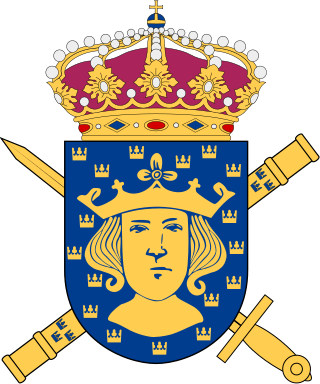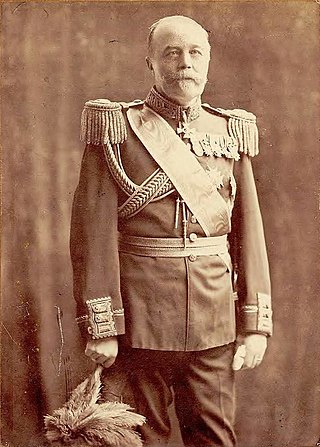Related Research Articles

Axel Gustafsson Oxenstierna was a Swedish statesman and Count of Södermöre. He became a member of the Swedish Privy Council in 1609 and served as Lord High Chancellor of Sweden from 1612 until his death. He was a confidant of King Gustavus Adolphus and then Queen Christina, for whom he was at first regent.

Dodo Freiherr zu Innhausen und Knyphausen was a German professional soldier who saw extensive service in the Thirty Years' War (1618–1648), rising to the rank of Field Marshal in Swedish service in 1633.

Lennart Torstensson, Swedish Field Marshal and later Governor-General of Pomerania, Västergötland, Dalsland, Värmland and Halland. He adapted the use of artillery on the battlefield, making it a more mobile weapon than previously known. Torstensson achieved important victories in the Thirty Years' War and in Sweden's war against Denmark (1643-45), which is named the Torstenson War after him. The period of his supreme command marks one of the most successful chapters in the military history of the Swedish army.

Count Magnus Gabriel De la Gardie was a Swedish statesman and military man. He became a member of the Swedish Privy Council in 1647 and came to be the holder of three of the five offices counted as the Great Officers of the Realm, namely Lord High Treasurer, Lord High Chancellor and Lord High Steward. He also served as Governor-General in the Swedish dominion of Livonia.
The General Staff was a Swedish government agency established in 1873 and was active until 1937. It was headed by the Chief of the General Staff which was a senior member of the Swedish Army.
The Royal Swedish Naval Staff College was a Swedish Navy training establishment between 1898 and 1961, providing courses for naval officers. It was the home of the Swedish Navy's staff college, which provided advanced training for officers. It was located within the Stockholm garrison in Stockholm, Sweden.
The Royal Swedish Army Staff College was a Swedish Army training establishment between 1866 and 1961, providing courses for army officers. It was the home of the Swedish Army's staff college, which provided advanced training for officers. It was located within the Stockholm Garrison in Stockholm, Sweden.

Artillery and Engineering College was a Swedish Army training establishment active between 1878 and 1992, providing courses for artillery officers. It was located within the Stockholm Garrison in Stockholm, Sweden.

Carl Einar Thure af Wirsén was a Swedish Army officer, diplomat and writer. Originally an officer, he was sent into the diplomatic service after World War I and served as a military attaché in Constantinople and Sofia where he witnessed the Armenian genocide. From the Ottoman Empire and the Balkans, af Wirsén came to Poland and witnessed the country's resurrection. After serving in London, Reval and Riga, he was sent as envoy to Bucharest, Athens and Belgrade in 1921. After working in the Mosul Commission, af Wirsén was sent to Berlin, where he would stay for the next 12 years as envoy. Finally he was envoy in Rome for three years before retiring in 1940.
Ministry of Land Defence was in a broad sense, one of the eight ministries, in which the Swedish government administration was divided into. Its head was called Minister of War. The Ministry of Land Defence Department was established on 16 May 1840 and was merged with the Ministry for Naval Affairs into the newly established Ministry of Defence on 30 June 1920.

The Surgeon-General of the Swedish Armed Forces is the highest-ranking medical officer of the Swedish Armed Forces. The Surgeon-General is responsible for the supervision of the Swedish Armed Forces, the Defence Materiel Administration, the Swedish Fortifications Agency and the National Defence Radio Establishment. This includes supervision in the areas of environment, health, nature, sewage, waste and chemicals.

The Commandant General in Stockholm is a military position in Sweden with responsibility for state ceremonial activities. Lieutenant General Michael Claesson, Chief of Defence Staff is the Commandant General in Stockholm since 2020.
The Swedish Army Veterinary Corps was an administrative corps for veterinarians of the Swedish Army from 1887 to 1969. Its task was, in peace as well as in war, to provide army units etcetera with especially trained staff for veterinary positions in the army.

Gabriel Bengtsson Oxenstierna af Korsholm och Wasa, 1st Count of Korsholma and Vaasa, Finnish: Gabriel Pentinpoika Oxenstierna, was a Swedish statesman, jurist and diplomat.

General Gustaf Fredrik Oskar Uggla was a senior Swedish Army officer. Uggla had a distinguished military career in Sweden during the late 19th and early 20th centuries. Commissioned in 1863, he rose through the ranks, serving in various capacities, including as a teacher at the Royal Military Academy and as a military attaché in Vienna. Uggla's career highlights include commanding the Royal Military Academy and later the 2nd Army Division. He retired as a general in 1913 but continued contributing to military committees.

General Hemming Gadd was a Swedish Army officer. His senior commands included regimental commander of the 2nd Life Grenadier Regiment and Svea Life Guards, as well as commander of the 4th Army Division. Gadd served as Chief of His Majesty's Military Staff from 1905 to 1907.
The Fleet Staff was a staff in the Swedish Navy created in 1884, that corresponded to the General Staff in the Swedish Army. It consisted of a commander with the rank of flag officer or captain, as well as a number of officers from the Swedish Navy and the Swedish Coastal Artillery, who were assigned to serve on the staff. The Fleet Staff's tasks included developing plans for the mobilization of the navy and handling issues related to the maintenance and use of naval forces; monitoring and proposing training and exercises for the personnel; monitoring the development of naval warfare both within and outside the country; conducting research in naval warfare history, drafting necessary regulations, and similar tasks; and conducting investigations in maritime military matters. The Fleet Staff was renamed on 31 December 1907 and became the Naval Staff.
The Swedish Army Medical Corps was from 1806 to 1969 an administrative corps of the Swedish Army, consisting of military surgeons. In 1969 the corps was amalmagated into the Medical Corps of the Swedish Armed Forces.
The Ministry of Education and Ecclesiastical Affairs was a ministry in Sweden established in 1840. The ministry dealt with matters concerning the church, education, science, culture, medical and general health care as well as poorhouses. The ministry was headed by the minister of education and ecclesiastical affairs. The ministry changed its name on 31 December 1967 to the Ministry of Education and Cultural Affairs.
The Court-Martial of Appeal was a Swedish court. It was the appellate court among military courts and heard cases appealed from regimental courts-martial. The establishment of Sweden's first military appellate court, the Colonel's War Court, occurred through Gustavus Adolphus' Articles of War in 1621. Later, during Queen Christina's reign, this court became a division of the War College. In 1791, the Court-Martial of Appeal was created, initially consisting of at least 7 members, including military officers and a justiciar. Dissolved briefly, it was revived in 1797 and designated as the appellate court during peacetime. Over time, its composition and role evolved, eventually becoming a division of the Svea Court of Appeal in 1916. Finally, with the Military Court Proceedings Act of 1948, military cases in peacetime transitioned to ordinary courts, leading to the abolition of the Court-Martial of Appeal in 1949.
References
Notes
- ↑ Westrin 1911 , p. 1303
- 1 2 3 4 Westrin 1911 , p. 1304
- ↑ Westrin 1911 , p. 1305
- Westrin, Theodor, ed. (1911). Nordisk familjebok: konversationslexikon och realencyklopedi (in Swedish). Vol. 14 (Ny, rev. och rikt ill. uppl. ed.). Stockholm: Nordisk familjeboks förl. SELIBR 8072220.